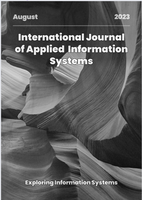The week's pick
Random Articles
Reseach Article
On Proficiency of HEED Protocol with Heterogeneity for Wireless Sensor Networks with BS and Nodes Mobility
| International Journal of Applied Information Systems |
| Foundation of Computer Science (FCS), NY, USA |
| Volume 2 - Number 7 |
| Year of Publication: 2012 |
| Authors: Manju Bala, Lalit Awasthi |
 http:/ijais12-450369
http:/ijais12-450369
|
Manju Bala, Lalit Awasthi . On Proficiency of HEED Protocol with Heterogeneity for Wireless Sensor Networks with BS and Nodes Mobility. International Journal of Applied Information Systems. 2, 7 ( May 2012), 58-62. DOI=http:/ijais12-450369
Abstract
In this paper, the enhancement of HEED protocol to support mobility in both homogenous and heterogeneous network [Homogeneous HEED (H-HEED), two-, three-level heterogeneous (2H-HHED & 3H-HEED) and multi-level heterogeneous HEED (MH-HEED)] has been presented. Here, we have examined the performance of HEED, 2H-HEED, 3H-HEED and MH-HEED with random mobility in wireless sensor network in terms of stability, energy efficiency, lifetime and throughput. The results establish that the MH-HEED in sensor network proved to be superior because of the enhancement in the performance metrics like: stability, lifetime and throughput (data packets transmitted to BS) with the random mobility of BS. The network performance is dominating in terms of stability, throughput and energy efficiency if 3H-HEED protocol is used and it is useful for habitat monitoring and other similar applications. The overall performance of the network substantially improved in case of BS mobility.
References
- Vierira, Marcos and Silva, Diogenes, "Survey on Wireless Sensor Network Devices", Technical report IEEE-0-7803-7937/03, Federal university of Minas Gerais, 2003.
- V. Raghunathan, C. Schurgers, Park. S, and M. B. Srivastava, "Energy-aware wireless microsensor networks," IEEE Signal Processing Magazine, Volume: 19 Issue: 2, March 2002 Page(s): 40 –50.
- I. Akyildiz et al. , "A Survey on Sensor Networks," IEEE Communication. Mag. , vol. 40, no. 8, Aug. 2002, pp. 102–14.
- Ossama Younis and Sonia Fahmy, "Distributed Clustering in Ad-hoc Sensor Networks: A Hybrid, Energy-Efficient Approach," in Proceedings of IEEE INFOCOM, Hong Kong, March 2004, an extended version appeared in IEEE Transactions on Mobile Computing, 3(4), Oct-Dec 2004.
- G. Smaragdakis, I. Matta, A. Bestavros, "SEP: A Stable Election Protocol for clustered heterogeneous wireless sensor networks", in Second International Workshop on Sensor and Actor Network Protocols and Applications (SANPA), 2004.
- Q. Li, Z. Qingxin, and W. Mingwen, "Design of a distributed energy efficient clustering algorithm for heterogeneous wireless sensor networks," Computer Communications, vol. 29, pp. 2230-7, 2006.
- Parul Saini and Ajay K Sharma, "Energy Efficient Scheme for Clustering Protocol Prolonging the Lifetime of Heterogeneous Wireless Sensor Networks", International Journal of Computer Applications (0975 – 8887) Volume 6– No. 2, pp. 31-36, September 2010
- Liu, B. , Brass, P. , Dousse, O. , Nain, P. , and Towsley, D. , "Mobility Improves Coverage of Sensor Networks", In MobiHoc '05: Proceedings of the 6th ACM International Symposium on Mobile Ad Hoc Networking and Computing, New York, NY, USA, ACM Press 300–308, 2005.
- Andrew Howard, Maja J Matari´c, and Gaurav S Sukhatme, "Mobile Sensor Network Deployment using Potential Fields: A Distributed, Scalable Solution to the Area Coverage Problem", In Proceedings of the 6th International Symposium on Distributed Autonomous Robotics Systems (DARS02) Fukuoka, Japan, June 25-27, 2002.
Index Terms
Keywords

